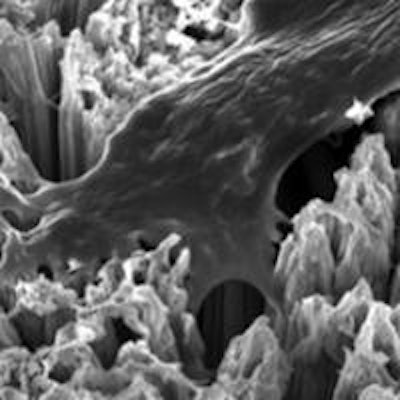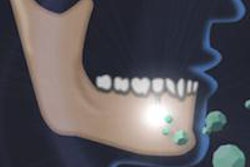
Researchers at Michigan Technological University (MTU) are using nanotechnology to improve the form and function of dental implants.
Tolou Shokuhfar, PhD, an assistant professor of mechanical engineering at MTU and the director of the In-Situ Nanomedicine Laboratory, is working with Cortino Sukotjo, DDS, PhD, a clinical assistant professor at the University of Illinois at Chicago (UIC) College of Dentistry on a dental implant with a surface made from titanium dioxide (TiO2) nanotubes. This material can help battle infection, improve healing, and help dental implants last a lifetime, according to the researchers.
 This shows a forest of titanium dioxide nanotubes etched into metallic titanium. The surface holds promise for improving the longevity of dental implants. All images courtesy of Tolou Shokuhfar, PhD.
This shows a forest of titanium dioxide nanotubes etched into metallic titanium. The surface holds promise for improving the longevity of dental implants. All images courtesy of Tolou Shokuhfar, PhD.
Toxicity tests on the nanotubes showed that they did not kill cells but encouraged growth, the researchers noted in a university news release. In addition, bone cells grow more vigorously and adhere better to titanium coated with TiO2 nanotubes than to conventional titanium surfaces. That could keep more dental implants in place, the researchers said.
In a paper accepted for publication by the journal Surface Innovations, the researchers describe their work showing that specially treated TiO2 nanotubes on the surface of orthopedic bone screws survive insertion and removal in bone simulant material.
Antimicrobial properties
 This is a bone cell anchoring itself to a surface of titanium dioxide nanotubes. Because osteoblasts readily adhere to this novel surface, dental implants coated with TiO2 nanotubes could significantly improve healing following dental implant surgery.
This is a bone cell anchoring itself to a surface of titanium dioxide nanotubes. Because osteoblasts readily adhere to this novel surface, dental implants coated with TiO2 nanotubes could significantly improve healing following dental implant surgery.
The nanotubes can also be used as a drug delivery system, the researchers noted (RSC Advances, July 19, 2013). Shokuhfar's team, in collaboration with Alexander Yarin, PhD, DSc, a professor in UIC's department of mechanical and industrial engineering, loaded TiO2 nanotubes with the anti-inflammatory drug sodium naproxen and demonstrated that it could be released gradually after implant surgery. That ensures that the medicine gets where it's needed, and it reduces the chances of unpleasant side effects that arise when a drug is injected or taken orally.
To fight infection, the TiO2 nanotubes can be laced with silver nanoparticles. Silver has antimicrobial properties, and scientists are capable of obtaining doses that can kill microbes but would not hurt healthy cells and tissues. In dentistry, the nanotubes could help prevent biofilms, which can cover implants and be very difficult to eradicate. A nanotextured implant surface embedded with silver nanoparticles could prevent infection for the life of the implant, according to Shokuhfar.
 This cutaway view of a titanium dioxide nanotube reveals the drug sodium naproxen on the inside. On the surface of a dental implant, these nanotubes could release this anti-inflammatory drug or other pharmaceuticals that could speed healing.
This cutaway view of a titanium dioxide nanotube reveals the drug sodium naproxen on the inside. On the surface of a dental implant, these nanotubes could release this anti-inflammatory drug or other pharmaceuticals that could speed healing.
"What we're developing is a surface that's inexpensive and easy to make and which can speed healing in so many ways," she said. "It can fight infection by adding antimicrobial silver and reduce inflammation by adding sodium naproxen. It's also likely that we could promote healing even more by incorporating a growth factor into the TiO2 nanotubes."
The TiO2 nanotubes also have a cosmetic advantage: transparency. That's a plus for any dental implant but especially for a new type made from zirconia, which some patients choose because it is totally white, the researchers noted.
The researchers have a provisional patent and are working with two hospitals to further develop the technology and eventually license it. They expect that implants with the new nanotubular surface will be easily assimilated into the market, since titanium implants, both dental and orthopedic, have a long history.



















